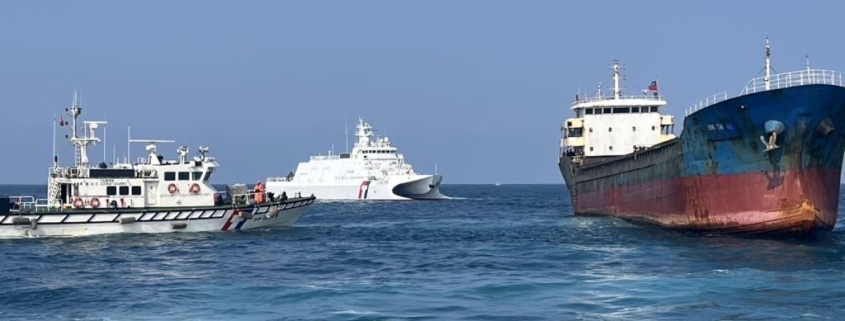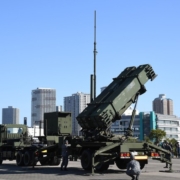China’s shadow fleet threatens Indo-Pacific communications
China is using increasingly sophisticated grey-zone tactics against subsea cables in the waters around Taiwan, using a shadow-fleet playbook that could be expanded across the Indo-Pacific.
On 25 February, Taiwan’s coast guard detained the Hong Tai 58 after a subsea cable was cut in the Taiwan Strait. The vessel was registered to Togo but crewed entirely by Chinese nationals. It had Chinese characters on its hull and operated under multiple identities with conflicting markings, documentation and tracking data. In another incident in early January, the Shunxing 39—a Chinese-owned vessel flagged under both Cameroon and Tanzania—was implicated in damaging a section of the Trans-Pacific Express subsea cable, an important telecommunications link between Taiwan and the United States.
While China has targeted Taiwan’s undersea cables for years as part of its grey-zone operations, it has subtly shifted tactics. Previously, vessels involved in suspected acts of sabotage were registered to China. Now, they are increasingly operating under foreign flags, forming a shadow fleet. This strategy resembles Russia’s subsea cable tactics in the Baltic Sea.
States such as North Korea and Iran often use shadow fleets—ageing vessels registered under flags of convenience—to get around sanctions, to trade or transport illegal or prohibited goods, or to undertake illegal fishing. The vessels are operated through intricate corporate structures, with shell companies established in one country, management based in another and vessels registered elsewhere again, providing states with deniability. They use deceptive tactics including manipulating identification systems, turning off tracking systems and changing names and flags. If caught, vessels can be easily abandoned and their legal entities dissolved, rendering traditional countermeasures such as sanctions largely ineffective.
Since its invasion of Ukraine, Russia has relied on a large shadow fleet, not only to evade oil sanctions but also to conduct a campaign of hybrid warfare against NATO—including allegedly damaging European subsea cables and critical infrastructure. For example, in December, Finnish authorities seized the Eagle S after it allegedly damaged five subsea cables. The tanker was flagged under the Cook Islands but operated by a Dubai-based company with Indian management. Moscow denied any involvement, pointing to the vessel’s non-Russian links.
China has also surfaced in Russia’s operations. In November, the Chinese-flagged Yi Peng 3—which had departed from a Russian port—was suspected of severing two undersea cables, one linking Lithuania to Sweden and another connecting Germany to Finland. In 2023, the NewNew Polar Bear, a Chinese-flagged but Russian-crewed vessel, was responsible for damaging Baltic subsea cables and a gas pipeline. China admitted the vessel was responsible for the damage, but claimed it was accidental.
These cases highlight the value of shadow fleets as tools of hybrid warfare. Subsea cables are notoriously susceptible to accidental and environmental damage. Proving intent to sabotage and holding parties accountable is very difficult.
Despite this, NATO has been working to expose and deter Russia’s hybrid warfare tactics.
Taiwan has taken note. In January, it blacklisted 52 Chinese-owned vessels suspected of operating as its shadow fleet registered in countries such as Cameroon, Tanzania, Mongolia, Togo and Sierra Leone. Following the recent cable-cutting incidents, Taiwanese authorities publicised detailed evidence—including vessel ownership, flag state and tracking system manipulation details—to pre-empt China’s denial. They have also been tracking and boarding suspicious vessels. Taiwan recently raised the alarm about a Russian-flagged vessel lurking for weeks over a subsea cable, recognising the growing coordination between China and Russia in hybrid warfare operations.
While Taiwan has borne the brunt of these efforts so far, China is unlikely to be overly concerned about deniability over future subsea cable sabotage affecting Taiwan. After all, Beijing’s primary goal is to exert pressure on the island, not conceal its intentions.
However, what happens in the Taiwan Strait will not stay in the Taiwan Strait. China’s shadow-fleet tactics are likely to expand across the Indo-Pacific, where maintaining a level of deniability would be beneficial. China already deploys grey-zone tactics in the region, from intimidation of vessels in the South China Sea and targeted incursions in disputed territorial waters, to strategic infrastructure investments that create leverage over its neighbours. Targeting subsea cable infrastructure is another tactic in Beijing’s coercion toolkit—one that targets connectivity while maintaining plausible deniability and operating in the grey-zones of international law and accountability.
The Indo-Pacific—with its vast maritime distances, congested shipping lanes and uneven surveillance capabilities—is fertile ground for such operations. Frequent accidental cable damage and existing territorial disputes may further complicate attribution and response. The region’s economic ties with China would make coordinating any responses even harder.
From filing patents on subsea cutting technology to unveiling a powerful new deep-sea cable cutting device, China’s clearly gearing up to expand its subsea cable operations. As Taiwan works to protect its critical infrastructure, the rest of the Indo-Pacific should enhance regional cooperation and reassess existing deterrence strategies.
If recent incidents in the Baltic Sea and around Taiwan are any indication, disruptions in the Indo-Pacific are not a question of if, but when. The most effective counter to Beijing’s shadow-fleet operations is exposure through public attribution and communication. After all, a vessel cutting cables near a state’s shores may well be flying a neighbour’s flag but taking its orders from Beijing.



